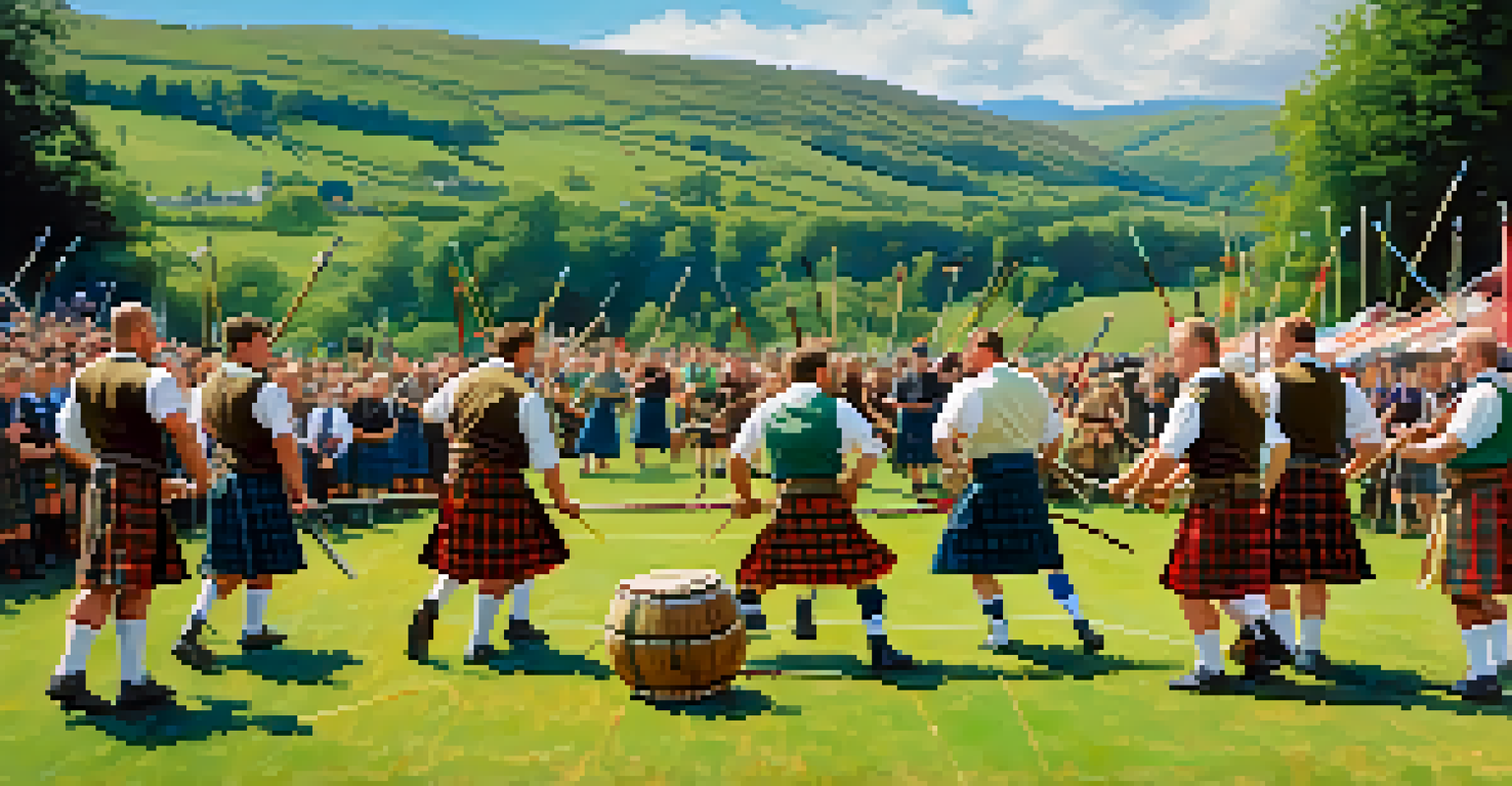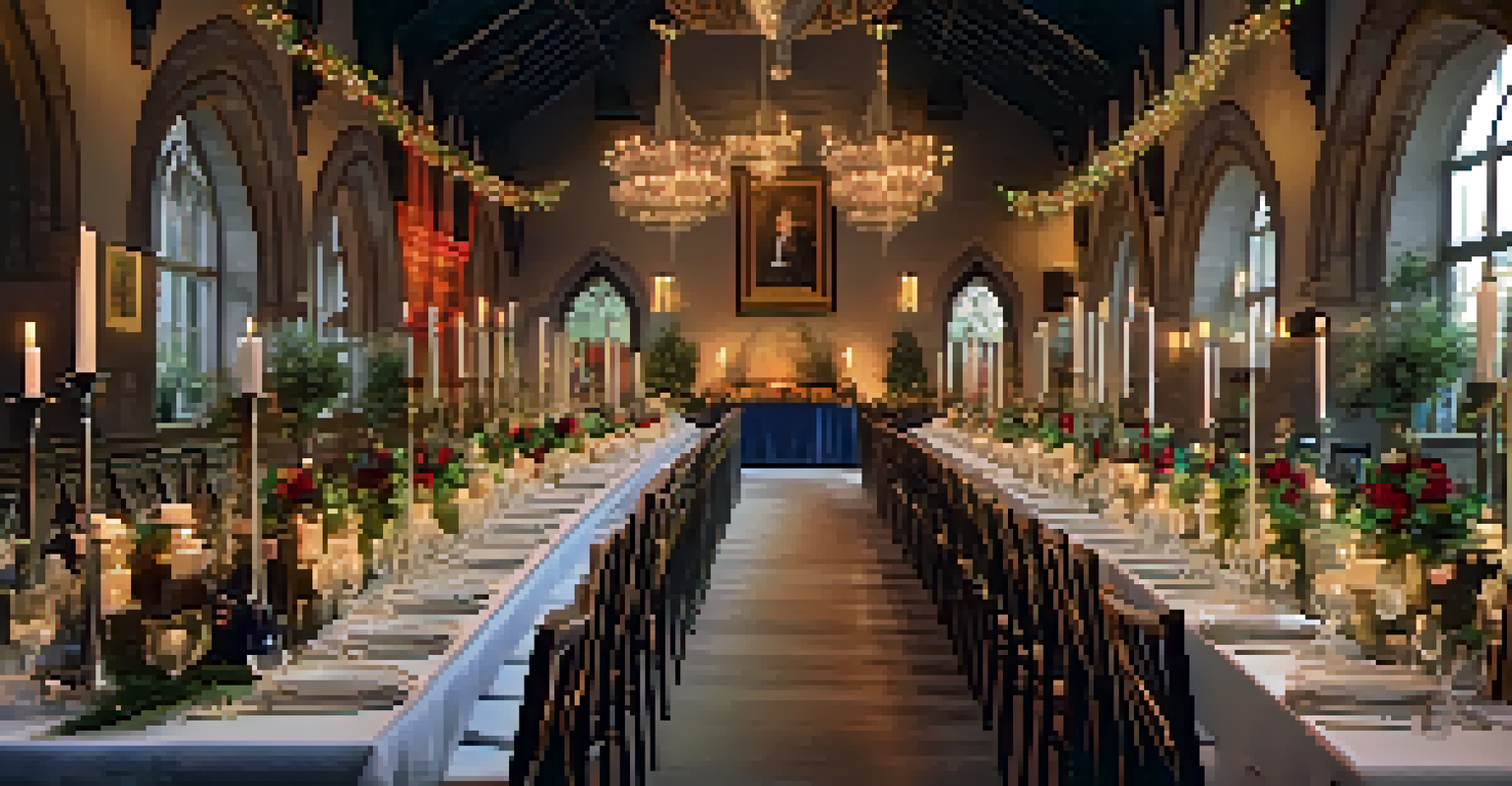Traditional Scottish Dress: Kilts and Their Cultural Relevance

The Origins of the Kilt in Scottish Culture
The kilt, often seen as a symbol of Scotland, has its roots in the 16th century. Originally, it was a full-length garment called the 'great kilt' or 'breacan feile', made from wool and worn by Highland clansmen. This garment allowed for mobility and warmth in the rugged Scottish terrain, making it practical for both everyday life and battle.
The kilt is a symbol of Scottish identity and pride, connecting us to our past and celebrating our heritage.
As the kilt evolved, it transformed into the more modern version we recognize today—typically knee-length and pleated at the back. This shift not only made the kilt more fashionable but also more accessible to different social classes in Scotland. The fabric and tartan patterns began to represent family clans and heritage, deepening its cultural significance.
Today, the kilt is not just a piece of clothing; it embodies Scottish identity and pride. Whether worn at weddings, festivals, or Highland games, it serves as a connection to the past, celebrating the rich history and traditions of Scotland.
Understanding Tartan: Patterns with Meaning
Tartan is the distinct patterned fabric most commonly associated with kilts, featuring crisscrossed horizontal and vertical bands in multiple colors. Each tartan design represents a specific clan or family, making it an important aspect of Scottish identity. For instance, the MacLeod tartan, with its striking yellow and black colors, signifies the heritage of the MacLeod clan.

The tradition of wearing specific tartans dates back centuries and has become a way for individuals to connect with their ancestry. In modern times, many people choose to wear clan tartans during significant life events to honor their heritage. This practice reinforces the bond between individuals and their Scottish roots.
Kilts: A Symbol of Scottish Identity
Kilts embody Scottish culture and heritage, serving as a visual representation of pride and belonging.
Moreover, tartan has transcended its original purpose, becoming a popular fashion statement worldwide. Designers have embraced tartan in various forms, from clothing to home decor, allowing this historic pattern to reach a global audience while maintaining its cultural significance.
Kilts in Modern Scottish Celebrations
Today, kilts are integral to many traditional Scottish celebrations, such as weddings, Highland games, and Burns Night. At weddings, grooms often don kilts as a way to pay homage to their heritage, adding a unique touch to the ceremony. This choice not only celebrates their ancestry but also showcases the beauty of traditional attire.
A tartan tells a story; it is a representation of clan, identity, and a link to our ancestors.
Highland games, which feature athletic competitions rooted in Scottish culture, often have competitors and spectators sporting kilts. This event is a vibrant display of Scottish pride, where the kilt symbolizes strength and connection to tradition. The sight of athletes in kilts, throwing cabers or competing in tug-of-war, creates a captivating atmosphere.
Additionally, events like Burns Night, honoring the famous Scottish poet Robert Burns, see attendees wearing kilts as a nod to their cultural heritage. These occasions provide a sense of community and belonging, reinforcing the idea that kilts are not just garments but a celebration of Scottish identity.
The Role of Kilts in Scottish Identity
Kilts are more than just traditional attire; they play a crucial role in shaping Scottish identity. For many, wearing a kilt evokes a sense of pride and belonging, connecting individuals to their roots and clan heritage. This garment serves as a visual representation of what it means to be Scottish, transcending generations.
In recent years, there has been a revival of interest in Scottish culture, with kilts becoming increasingly popular not only among Scots but also among global enthusiasts. This trend reflects a growing appreciation for cultural heritage and a desire to celebrate diversity through traditional dress.
Tartan Patterns Reflect Clan Heritage
Each tartan design represents a specific clan, reinforcing connections to ancestry and cultural significance.
Moreover, the kilt's presence in popular culture—from films to music festivals—has further solidified its status as a symbol of Scottish pride. This visibility encourages a broader understanding of Scottish traditions, allowing kilts to foster connections among people of all backgrounds.
Caring for Your Kilt: Tips and Best Practices
Caring for a kilt is essential to maintain its beauty and longevity. Most kilts are made from wool, which can be sensitive to moisture and dirt. To keep your kilt looking its best, it’s important to follow specific cleaning and storage guidelines, such as storing it in a breathable garment bag and avoiding direct sunlight.
When it comes to cleaning, many kilts can be dry cleaned, but always check the care label before proceeding. If your kilt gets soiled, spot cleaning with a damp cloth and gentle detergent is often recommended. Regular maintenance helps preserve the integrity of the fabric and the vibrancy of the tartan patterns.
Additionally, understanding how to properly wear a kilt is vital. Ensure it fits correctly and is worn at the natural waist to achieve the classic look. By taking care of your kilt, you can ensure that this cherished piece of Scottish culture remains a part of celebrations for years to come.
Kilts Beyond Scotland: Global Influence
The influence of kilts has spread far beyond the borders of Scotland, inspiring fashion and culture worldwide. From military uniforms to modern-day fashion shows, the kilt's unique silhouette and rich history have captivated designers and enthusiasts alike. This global appeal showcases how traditional attire can transcend cultural boundaries.
In many countries, the kilt has been embraced in various forms, often adapted to fit local customs and styles. For example, in Canada, the kilt is worn during cultural festivals, while in the United States, it has become a popular choice for St. Patrick's Day celebrations. This adaptability highlights the kilt's ability to resonate with diverse audiences.
Global Influence of the Kilt
Kilts have transcended their Scottish origins, inspiring fashion and cultural events worldwide.
Moreover, the rise of Scottish-themed events and festivals around the world has led to an increased appreciation for kilts and Scottish culture. As people participate in these celebrations, they not only honor Scottish traditions but also create a shared experience that fosters cultural exchange and understanding.
The Future of Kilts: Tradition Meets Modernity
As society evolves, so does the perception and use of kilts. Today, designers are experimenting with materials, styles, and colors, blending traditional craftsmanship with modern aesthetics. This fusion allows kilts to remain relevant while appealing to a younger audience, ensuring that the tradition continues.
Furthermore, the rise of sustainable fashion has led some makers to focus on eco-friendly materials and practices when creating kilts. This shift not only preserves the cultural significance of the garment but also aligns with contemporary values centered around sustainability and ethical production.

Ultimately, the future of kilts lies in their ability to adapt while staying true to their roots. As new generations embrace this iconic piece of Scottish dress, they will continue to carry forward its rich history and cultural relevance, ensuring that kilts remain a celebrated symbol of Scotland.